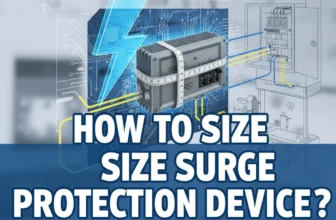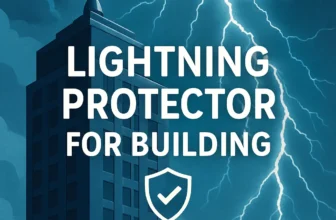
Imagine the frustration of losing your valuable electronics due to unexpected high-voltage surges. Hence, protecting your household devices from such electrical threats should not be a second thought. Over-voltage protection ensures that your gadgets at home remain safe from these sudden spikes. Did you know that overvoltages are the leading cause of damage to electronic equipment?
27 out of 100 cases of damage stem from these electrical surges. Understanding and implementing effective voltage protection measures can safeguard your home and avoid costly repairs or replacements. Below are five ways to help shield your home from these electrical hazards.
Use Electrical Fuses
Imagine the peace of mind knowing your home is shielded from unexpected electrical surges. Using electrical fuses is a simple yet effective way to protect your household devices from overvoltage. Let’s get into why you should consider this option and how to get started.
Why I Recommend It?
Explanation of the benefits of using fuses
Electrical fuses act as the first line of defense against overvoltage. They are designed to break the circuit when the current exceeds a safe level, preventing potential damage to your appliances.
This proactive measure can save you from costly repairs and replacements. Fuses are reliable, cost-effective, and easy to replace, making them an ideal choice for homeowners.
How fuses prevent damage from overvoltage
When a surge occurs, the electrical fuse detects the excess current and interrupts the flow, effectively cutting off the power supply to your devices. This action prevents overheating and potential fires, ensuring the safety of your home.
Installing fuses lets you create a barrier that stops overvoltage in its tracks.
What Do You Need?
List of necessary materials and tools
To install electrical fuses, you’ll need the following materials and tools:
-
Electrical fuses: Choose the appropriate type and rating for your home.
-
Fuse holder: Securely holds the fuse in place.
-
Screwdriver: For opening the fuse box and securing connections.
-
Wire cutter/stripper: To prepare wires for connection.
Where to purchase quality fuses
You can find quality electrical fuses at most hardware stores or online retailers. Look for reputable brands that offer reliable performance and durability.
Be sure to choose fuses that match the specifications of your home’s electrical system.
Step by Step Instructions
How to install fuses in your home
-
Turn off the power: Before starting, ensure the main power supply is switched off to avoid any electrical hazards.
-
Open the fuse box: Use a screwdriver to carefully open the fuse box cover.
-
Identify the circuit: Determine which circuit requires a fuse and locate the corresponding slot.
-
Install the fuse: Insert the electrical fuse into the holder and secure it in the designated slot.
-
Close the fuse box: Once the fuse is in place, close the fuse box cover and tighten any screws.
Safety precautions to follow
-
Always turn off the power before working with electrical components.
-
Use the correct type and rating of fuse for each circuit.
-
Ensure all connections are secure to prevent loose wires.
-
Regularly check fuses for signs of wear or damage and replace them as needed.
Follow the above steps and you can effectively use electrical fuses to protect your home from overvoltage. This simple addition to your electrical system can make a significant difference in safeguarding your valuable electronics.
Common Mistakes to Avoid | Pitfalls
Incorrect installation issues
When installing electrical fuses, you might face some common pitfalls. One major issue is incorrect installation. If you don’t secure the fuse properly, it won’t function as intended. This can leave your devices vulnerable to overvoltage.
Always double-check that the fuse is firmly in place and that all connections are tight. Loose connections can lead to overheating and potential hazards.
Choosing the wrong type of fuse
Another mistake is selecting the wrong type of fuse. Not all fuses are created equal. Each has a specific rating and purpose. Using a fuse with an incorrect rating can result in inadequate protection. It might either blow too easily or fail to protect your devices during a surge.
Therefore, you will want to match the fuse type and rating to your home’s electrical system. Consult your fuse box’s specifications or seek professional advice if you’re unsure.
Who Should Try This?
Homeowners with frequent voltage fluctuations
If your home experiences frequent voltage fluctuations, installing electrical fuses is a wise choice. These fluctuations can occur due to various reasons, such as faulty appliances or overloaded circuits.
Use fuses to mitigate the risk of damage to your electronics. Conduct an audit of your circuits to identify any potential overloads.
This proactive step can help you maintain a safe and efficient electrical system.
Individuals looking for a cost-effective solution
For those seeking a cost-effective solution to protect their home electronics, electrical fuses offer an affordable option. They provide reliable protection without breaking the bank.
Unlike more expensive surge protection systems, fuses are easy to replace and maintain. You can find quality fuses at local hardware stores or online, making them accessible for any budget. When you invest in fuses, you ensure peace of mind without a hefty price tag.
Install Surge Protection Devices
Imagine the relief of knowing your home is shielded from unexpected electrical surges. Surge protection devices offer a robust solution to safeguard your valuable electronics.
Let’s explore why these devices are essential and how you can integrate them into your home.
Why I Recommend It?
Advantages of surge protectors
Surge protectors act as a barrier between your devices and sudden voltage spikes. They absorb excess voltage, preventing it from reaching your electronics.
This protection ensures that your gadgets remain safe from damage. Surge protectors are especially useful in areas prone to electrical storms or frequent power fluctuations. By installing them, you reduce the risk of costly repairs or replacements.
Long-term benefits for home safety
In the long run, surge protectors play a significant role in enhancing home safety. They prevent potential fires caused by electrical overloads. This proactive measure not only protects your devices but also ensures the safety of your family.
With surge protectors, you can enjoy peace of mind knowing that your home is well-protected against electrical threats.
What Do You Need?
Types of surge protection devices
There are several types of surge protection devices available:
-
Whole-house surge protectors: Installed at the main electrical panel, these provide comprehensive protection for your entire home.
-
Point-of-use surge protectors: These are plug-in devices used for individual appliances or electronics.
-
Power strips with surge protection: These offer convenience and protection for multiple devices connected to a single outlet.
Recommended brands and models
When choosing surge protectors, consider reputable brands known for their reliability and performance. Some recommended options include:
-
APC SurgeArrest: Offers a range of models suitable for different needs.
-
Belkin SurgeMaster: Known for its durability and effectiveness.
-
Tripp Lite Isobar: Provides high-quality protection with a robust design.
Step by Step Instructions
Guide to installing surge protectors.
-
Identify the devices: Determine which electronics require surge protection.
-
Choose the right type: Select a surge protector that suits your needs, whether it’s a whole-house unit or a point-of-use device.
-
Install the device: For whole-house protectors, hire a professional electrician to ensure proper installation. For plug-in devices, simply connect them to the appropriate outlets.
-
Test the protection: After installation, test the surge protector to ensure it’s functioning correctly.
Maintenance tips for optimal performance
-
Regularly inspect: Check your surge protectors for any signs of wear or damage.
-
Replace when necessary: Surge protectors have a limited lifespan. Replace them if they show signs of malfunction or after a significant surge event.
-
Keep them clean: Dust and debris can affect performance. Clean your surge protectors periodically to maintain their effectiveness.
Common Mistakes to Avoid | Pitfalls
When it comes to surge protection, you might think it’s as simple as plugging in a device and forgetting about it. However, there are common pitfalls that can undermine your efforts to protect your home.
Let’s walk through these mistakes and how you can avoid them.
Overloading Surge Protectors
You might be tempted to plug multiple devices into a single surge protector, thinking it can handle the load. However, overloading a surge protector can lead to serious issues.
Each surge protector has a maximum load capacity, and exceeding this can cause it to fail. This failure leaves your electronics vulnerable to high-voltage spikes.
To prevent this, always check the load capacity of your surge protector and ensure you’re not exceeding it. Spread your devices across multiple surge protectors if necessary.
Ignoring Device Specifications
Another common mistake is ignoring the specifications of your surge protection devices. Not all surge protectors are created equal.
Some are designed for small electronics, while others can handle larger appliances. Using the wrong type can result in inadequate protection.
Always read the specifications and choose a surge protector that matches the needs of your devices. This ensures optimal protection and extends the lifespan of your electronics.
Who Should Try This?
Surge protection isn’t just for tech enthusiasts or those with expensive gadgets. It’s a crucial step for anyone looking to safeguard their home.
Homeowners with Valuable Electronic Equipment
If you have valuable electronics, such as high-end TVs, computers, or gaming consoles, surge protection is a must. These devices are particularly sensitive to power surges and can suffer significant damage without proper protection.
When you invest in quality surge protectors, you can avoid costly repairs or replacements.
Those Living in Areas Prone to Electrical Storms
Living in an area prone to electrical storms increases the risk of power surges. Lightning strikes can cause sudden spikes in voltage, damaging your home’s electrical system.
Installing surge protection devices provides a buffer against these unpredictable events. It ensures your home remains safe, even during severe weather conditions.
Implement Voltage Monitoring
Imagine having the ability to foresee electrical issues before they wreak havoc on your home. Voltage monitoring offers this foresight, allowing you to keep a vigilant eye on your home’s electrical health.
Let’s explore why this proactive approach is essential and how you can implement it.
Why I Recommend It?
Importance of monitoring voltage levels
Monitoring voltage levels in your home is like having a security system for your electrical setup. It helps you detect anomalies that could indicate potential problems.
Voltage monitor keeps track of voltage fluctuations and you can prevent damage to your appliances and avoid costly repairs. This vigilance ensures that your devices operate within safe parameters, extending their lifespan and maintaining efficiency.
How it helps in early detection of issues
Early detection is crucial in preventing electrical mishaps. Voltage monitoring systems alert you to irregularities, such as sudden spikes or drops in voltage.
These alerts give you the chance to address issues before they escalate into major problems. Act swiftly and you can protect your home from the dangers of overvoltage, ensuring a stable power supply.
What Do You Need?
Voltage monitoring devices
To start monitoring voltage levels, you’ll need reliable voltage monitoring devices. These gadgets continuously measure the voltage in your electrical system and provide real-time data. Some popular options include:
-
Fluke VR1710: Known for its accuracy and ease of use.
-
P3 International P4400 Kill A Watt: Offers detailed insights into your power usage.
-
TED Pro Home: Provides comprehensive monitoring for the entire house.
Software options for tracking
Pairing your monitoring devices with software enhances their functionality. Software solutions allow you to track voltage data over time, identify patterns, and receive alerts. Consider these options:
-
Sense Energy Monitor: Offers detailed analytics and real-time alerts.
-
Emporia Vue: Provides easy-to-understand reports and notifications.
Step by Step Instructions
Setting up voltage monitoring systems
-
Choose your device: Select a voltage monitoring device that suits your needs and budget.
-
Install the device: Follow the manufacturer’s instructions to install the device in your electrical panel or outlet.
-
Connect to software: If using software, connect your device to the app or platform for enhanced tracking.
-
Configure alerts: Set up alerts for voltage fluctuations to receive timely notifications.
Interpreting data and taking action
Once your system is up and running, it’s time to make sense of the data:
-
Review voltage trends: Regularly check the data to spot any unusual patterns or spikes.
-
Investigate anomalies: If you notice irregularities, investigate the cause and take corrective action.
-
Consult professionals: For persistent issues, consider consulting an electrician to assess your electrical system.
Common Mistakes to Avoid | Pitfalls
Navigating the world of voltage monitoring can feel like a maze. You might think it’s just about setting up a device and letting it do its thing. But there are common pitfalls that can trip you up.
Misreading Voltage Data
You might find yourself staring at numbers and graphs, trying to make sense of it all. Misreading voltage data is a common issue. It can lead to unnecessary panic or, worse, ignoring real problems.
To avoid this, familiarize yourself with the normal voltage range for your home. Most homes operate between 110-120 volts. If your readings consistently fall outside this range, it might be time to investigate further. Use the software tools that come with your monitoring devices.
They often provide visual aids and alerts to help you accurately interpret the data.
Delayed Response to Alerts
Imagine your monitoring system sends an alert about a voltage spike, but you ignore it. Delayed responses can lead to significant damage. When you receive an alert, act promptly.
Check your devices and circuits for any signs of trouble. If you’re unsure, consult a professional. Quick action can prevent minor issues from escalating into costly repairs.
Who Should Try This?
Voltage monitoring isn’t just for tech enthusiasts. It’s a smart move for anyone who wants to keep their home safe and efficient.
Tech-savvy Homeowners
If you love gadgets and technology, voltage monitoring is right up your alley. You’ll enjoy the process of setting up devices and analyzing data. Plus, you’ll have peace of mind knowing your home is protected.
With the right tools, you can even integrate voltage monitoring into your smart home system, giving you control at your fingertips.
Those Interested in Proactive Home Management
Are you someone who likes to stay ahead of potential problems? Voltage monitoring offers a proactive approach to home management. Always keep an eye on your electrical system, and you can catch issues before they become major headaches.
This foresight not only protects your devices but also ensures a stable and efficient power supply. It’s a small investment that pays off in the long run.
Consult with Professionals
Ever felt overwhelmed by the complexities of your home’s electrical system? You’re not alone. Many homeowners face challenges when dealing with overvoltage protection.
Consulting with professionals can be a game-changer. Let’s explore why this step is crucial and how you can make the most of it.
Why I Recommend It?
Benefits of Professional Assessment
Professional assessments offer peace of mind. Experts can identify potential risks that might go unnoticed. They possess the necessary tools and knowledge to thoroughly evaluate your home’s electrical system. This evaluation helps pinpoint vulnerabilities and suggest effective solutions.
When you sign up for a professional assessment, you ensure that your home is safeguarded against overvoltage threats.
Expertise in Identifying Potential Risks
Electricians bring a wealth of experience to the table. They can spot issues that might seem trivial to the untrained eye. Their expertise allows them to recommend tailored solutions for your specific needs.
This personalized approach ensures that your home receives the best protection possible. Trusting professionals means you’re investing in the safety and longevity of your household electronics.
What Do You Need?
Finding Qualified Electricians
Finding the right electrician is crucial. Look for licensed professionals with positive reviews. Check their credentials and ask for references.
Websites like Angie’s List or HomeAdvisor can help you find reputable electricians in your area. A qualified electrician will have the necessary skills to assess and address your home’s electrical needs.
Preparing for a Consultation
Preparation is key to a successful consultation. Start by listing any electrical issues you’ve noticed. Gather information about your home’s electrical system, such as the age of the wiring and any past repairs.
This information will help the electrician understand your situation better. Being prepared ensures that you get the most out of your consultation.
Step by Step Instructions
How to Schedule and Conduct a Consultation
-
Research and Contact: Begin by researching local electricians. Contact a few to discuss your needs and schedule a consultation.
-
Prepare Your Questions: Write down any questions or concerns you have. This will help guide the conversation during the consultation.
-
Conduct the Consultation: During the meeting, walk the electrician through your home. Point out any areas of concern and provide them with your prepared information.
-
Review Recommendations: After the assessment, review the electrician’s recommendations. Discuss any proposed solutions and ask for clarification if needed.
Questions to Ask During the Assessment
-
What are the potential risks in my current electrical setup?
-
How can I improve my home’s overvoltage protection?
-
What are the costs associated with the recommended solutions?
-
How often should I schedule maintenance checks?
By consulting with professionals, you gain valuable insights into your home’s electrical health. This proactive step not only protects your devices but also ensures a safe living environment.
Final Thoughts
Protecting your home from overvoltage is not just a precaution; it’s a necessity. By implementing the solutions discussed, you ensure the safety and longevity of your electronics. Imagine the peace of mind knowing your devices are shielded from unexpected electrical surges.
Each method, from using fuses to consulting professionals, plays an important role in safeguarding your home. Regular maintenance and inspections further enhance this protection. Don’t wait for an electrical mishap to take action.
Check out these strategies today and enjoy a safer, more secure home environment.








